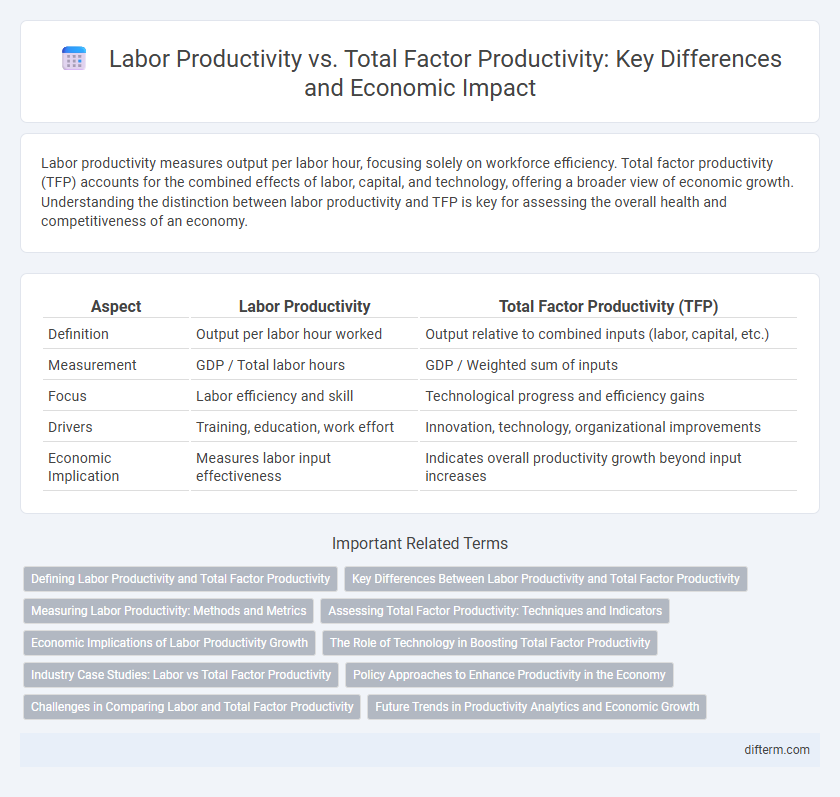Labor productivity measures output per labor hour, focusing solely on workforce efficiency. Total factor productivity (TFP) accounts for the combined effects of labor, capital, and technology, offering a broader view of economic growth. Understanding the distinction between labor productivity and TFP is key for assessing the overall health and competitiveness of an economy.
Table of Comparison
| Aspect | Labor Productivity | Total Factor Productivity (TFP) |
|---|---|---|
| Definition | Output per labor hour worked | Output relative to combined inputs (labor, capital, etc.) |
| Measurement | GDP / Total labor hours | GDP / Weighted sum of inputs |
| Focus | Labor efficiency and skill | Technological progress and efficiency gains |
| Drivers | Training, education, work effort | Innovation, technology, organizational improvements |
| Economic Implication | Measures labor input effectiveness | Indicates overall productivity growth beyond input increases |
Defining Labor Productivity and Total Factor Productivity
Labor productivity measures the output generated per hour of labor input, reflecting the efficiency of human work in producing goods and services. Total factor productivity (TFP) assesses the overall efficiency of all inputs, including labor, capital, and technology, in contributing to economic output beyond mere input quantities. Understanding labor productivity and TFP is essential for analyzing economic growth drivers and the impact of technological advancements on production efficiency.
Key Differences Between Labor Productivity and Total Factor Productivity
Labor productivity measures the output produced per labor hour, reflecting efficiency in workforce utilization, whereas total factor productivity (TFP) assesses output relative to combined inputs, including labor, capital, and technology, capturing overall efficiency and innovation effects. Key differences include labor productivity's focus on labor input alone, whereas TFP accounts for multiple production factors, making it a broader indicator of economic performance. Economies with rising TFP typically experience sustainable growth driven by technological advancement and efficiency improvements beyond mere labor increases.
Measuring Labor Productivity: Methods and Metrics
Measuring labor productivity involves assessing output per labor hour using metrics such as output per worker and output per hour worked, which reflect efficiency in utilizing workforce inputs. Common methods include index numbers like the labor productivity index derived from real output divided by labor input and growth accounting frameworks that isolate labor's contribution to output changes. Accurate labor productivity measurement relies on high-quality data encompassing hours worked, employee numbers, and sector-specific output to distinguish between labor input changes and technological advancements captured by total factor productivity.
Assessing Total Factor Productivity: Techniques and Indicators
Total Factor Productivity (TFP) measures the efficiency of all inputs in the production process, capturing technological improvements beyond labor and capital contribution. Techniques for assessing TFP include growth accounting methods and econometric models that decompose output growth to isolate productivity changes. Key indicators for TFP evaluation incorporate efficiency indices, innovation rates, and resource allocation effectiveness, providing a comprehensive view of economic performance beyond labor productivity alone.
Economic Implications of Labor Productivity Growth
Labor productivity growth directly enhances output per worker, driving wage increases and improving living standards. It stimulates economic expansion by enabling businesses to produce more goods and services without proportionally increasing labor input. This growth reduces unit labor costs, making industries more competitive internationally and attracting investment.
The Role of Technology in Boosting Total Factor Productivity
Technology acts as a critical driver in enhancing Total Factor Productivity (TFP) by improving the efficiency with which labor and capital inputs are utilized. Innovations such as automation, artificial intelligence, and advanced data analytics enable firms to produce more output without increasing input quantities, leading to sustained economic growth. Unlike labor productivity, which measures output per worker, TFP captures these technological improvements' broader impact on the overall production process.
Industry Case Studies: Labor vs Total Factor Productivity
Industry case studies reveal that labor productivity measures output per labor input, emphasizing workforce efficiency, while total factor productivity (TFP) accounts for all inputs, including capital and technology, highlighting overall production efficiency. In manufacturing sectors, increases in labor productivity often stem from workforce skill development, but TFP gains are driven by technology adoption and process innovation. Empirical data from automotive and electronics industries demonstrate that sustained growth depends more heavily on TFP improvements than on labor productivity alone.
Policy Approaches to Enhance Productivity in the Economy
Labor productivity improvements often result from optimizing human capital, investing in skills development, and adopting advanced technologies, while total factor productivity (TFP) growth hinges on innovation, efficient resource allocation, and institutional reforms. Policy approaches to enhance productivity include incentivizing research and development, improving infrastructure, fostering competitive markets, and streamlining regulations to reduce barriers to business efficiency. Targeted government interventions supporting education, technology adoption, and market flexibility directly contribute to sustainable economic growth through simultaneous gains in labor productivity and TFP.
Challenges in Comparing Labor and Total Factor Productivity
Labor productivity focuses on output per worker, while total factor productivity (TFP) accounts for all input factors including capital and technology, making direct comparisons challenging due to differing measurement scopes. Variability in data quality, sector-specific technology adoption, and capital intensity further complicate accurate assessments of the relative efficiency captured by labor productivity versus TFP. Addressing these discrepancies requires robust methodologies that adjust for input heterogeneity and productivity spillovers in multifactor environments.
Future Trends in Productivity Analytics and Economic Growth
Future trends in productivity analytics emphasize integrating advanced machine learning algorithms and big data to enhance the measurement of Labor Productivity and Total Factor Productivity (TFP). Enhanced analytics enable more precise identification of productivity drivers, facilitating targeted economic policies that stimulate innovation and sustainable growth. Continuous improvements in TFP tracking are expected to play a critical role in forecasting long-term economic expansion by encompassing technological progress and efficiency gains beyond labor input.
Labor Productivity vs Total Factor Productivity Infographic

 difterm.com
difterm.com